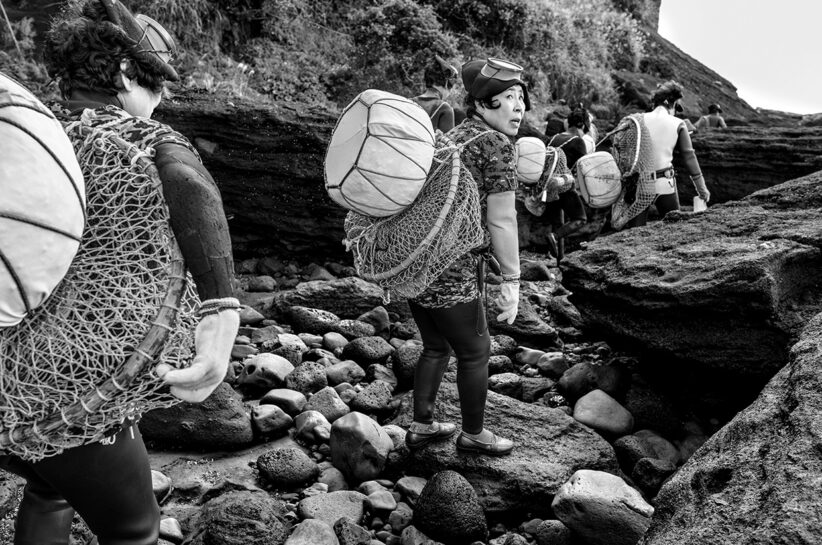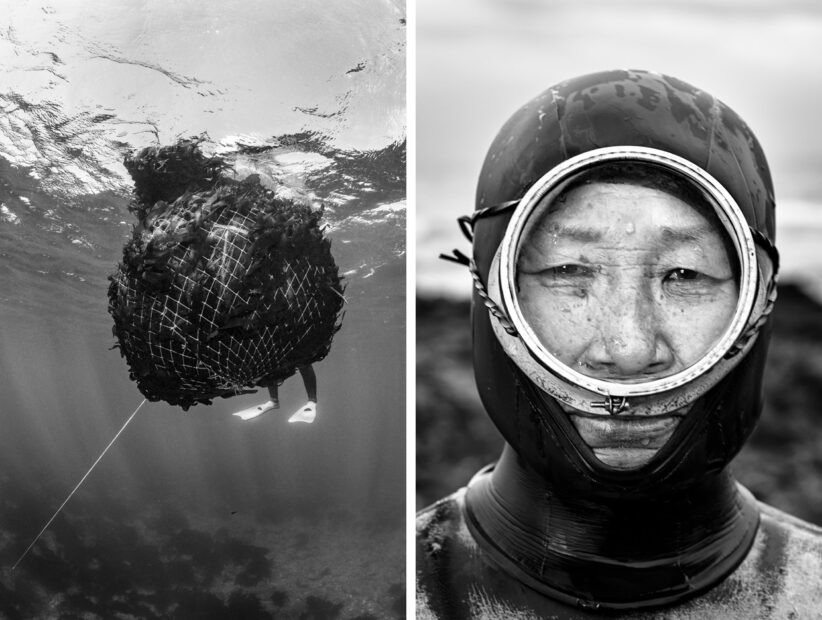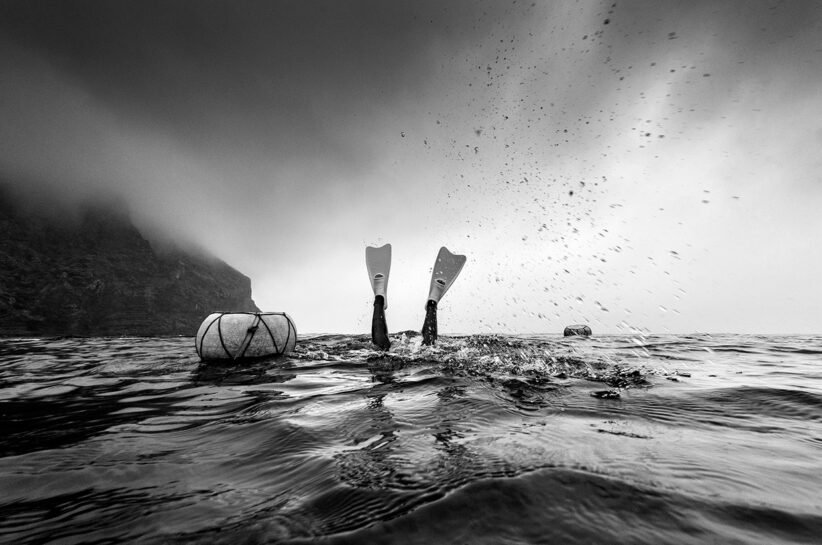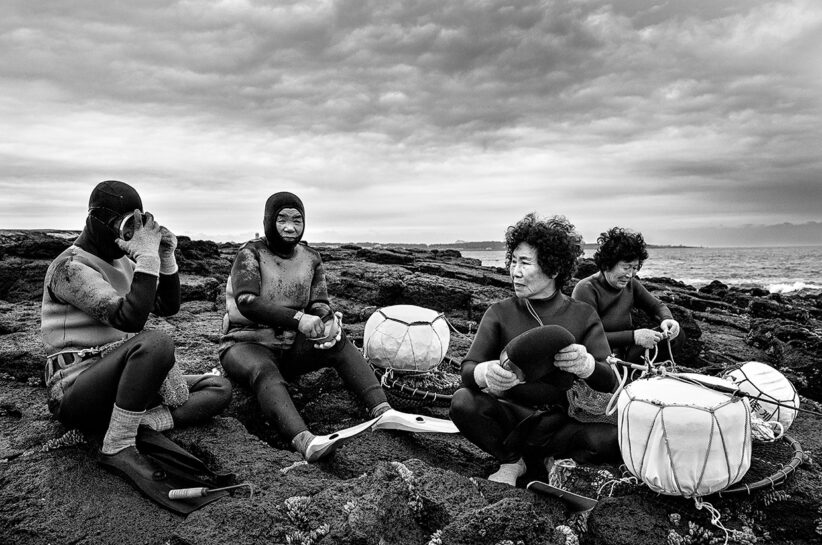Women of the Sea
Diving with the Haenyeo of Jeju
Words and Photography by Luciano Candisani
Friendly smiles. Jokes and laughter. Woolly socks and gloves keep hands and feet warm in the chill. On with the flippers and dive masks.
At last, after days on the South Korean island of Jeju waiting for conditions, I am out at sea with a group of the haenyeo. The open fishing boat cuts through mirror-calm waters just after dawn. There is little sound but the chug of the engine and the excited chatter of the 10 or so women as they make ready for their dive. I sit and listen to their stories, told in a language I cannot understand, but the women have already made me feel at home among them and nobody minds the click of my camera’s shutter.
Each of the haenyeo has a tewak: a collection net attached to a large orange float, and I imagine what the nets will look like when swollen with a treasure of glistening shells in a few hours’ time. Sooner than I expect, the tewaks have been thrown overboard and now the floats bob on the surface, marking each diver’s patch. Then the haenyeo follow. The women – most of whom are grandmothers – are up and over the gunwale in moments, and I marvel at their efficiency. They have had a lot of practice, over many decades.
I look over the side. Their neoprene-clad heads look a little like seals, slick with water, until I catch the glint of early morning light on the glass of a dive mask, breaking the illusion. One of the women waves to me; I wave back. A haunting whistling sound rises up in the silence of the morning. It sounds almost like the warbling call of a colony of seabirds, but I realise at once that they are hyperventilating, saturating their blood with oxygen before diving metres down to the life-rich seabed where they will begin their search for marine organisms.
The whistling stops. The women dive. Fins kick skyward and they are gone.
***
I have always had a visceral connection to the sea. I am fascinated by the people whose livelihoods depend on it, and I have come to Jeju to learn more about a traditional way of life that, like many such cultures, is at risk of dying out. At the age of 90, Hyun Seon-jik still spends most of her time in the sea, out beyond the waves of Samdal-ri beach. She swims a five-hour shift with her fellow divers, searching for the seafood she collects for trading. Only shells that have grown over 7cm in size are taken; anything smaller is returned to the water to grow. I’ve enjoyed several chats via interpreter with Hyun since arriving here, and have found her a sharp and perceptive conversationalist, with a fierce love of the place she has called home all her life. ‘Of course I like the sea!’ she told me a few days ago. ‘I’ve lived my whole life in the sea. It is my home, my patrimony, my family. My patrimony,’ she said again. Then, ‘When I get up, I see the sea and am delighted. Even lying down I imagine the sound of the sea.’ Her friend asked her how long she plans to keep diving for. ‘I’m 90!’ was her reply. ‘Till 100. Can’t you catch sea urchins at 100?’



Now Hyun is silent and businesslike as she tiptoes in socks over the black volcanic rocks of the foreshore towards the surf. She is more surefooted than I am on this terrain; I stumble as I try to keep up with her. Her body is wrapped in a neoprene suit, and she carries a round face mask, fins, and a belt with lead weights. She has tucked her long silver mane under her black hood and carries her tewak, with its orange plastic float, on her back. With this simple attire she dives repeatedly, with only the air in her lungs, to a depth of 7m to collect conches, sea urchins, seaweed, and octopi. It is something she has been doing ever since she first learnt the art of freediving from her mother, 75 years ago. She’s a sea-woman: a haenyeo, as they call the divers who have made their living from the waters of Jeju over many generations. She throws her float and tewak into the swell, dives, and vanishes from sight.
Hyun and other divers scattered around these coastal villages are the conservers of a practice that arose here four centuries ago. On Jeju, the first records of diving stem from the 17th century, and it was initially practised both by men and women. However, the abalone – most noble of molluscs – was confiscated for tax reasons by the royal government. Outraged by the abusive charges, male divers, known as pojak, started leaving Jeju by the thousands, often seeking work in distant lands. Many were also drafted into the army. With no alternatives, women turned to the sea for survival. Tightly organised, they developed a unique protocol of procedures and practices that included rudimentary equipment along with breathing and diving techniques seen nowhere else.
These traditions soon extended to dry land. After each journey to the sea the women would return to their stone shelters and gather around bonfires, talking in their own haenyeo dialect. They began to practise then-marginalised shamanic rituals, brought to Korea by nomadic peoples from Siberia and Manchuria around 6,000 years ago. With offerings to nature gods, they would thank these animist entities for the copious sea life received, asking for protection against strong underwater currents, storms, and marine predators. A systematic and cohesive culture arose, founded and managed by the women themselves, in a society ruled by state ideologies holding that women should be subservient to men.
The haenyeo culture sprang up during a time when oppressive legislation was forced upon Korean women. Women should be limited to domestic work and the care of children. They had no access to education, no right to inheritance. They were discouraged from walking in public spaces; when they did, their faces should be hidden by a veil. Divorce procedures could only be initiated by men. Husbands could abandon their wives should they fail to bear a male child. Unshackled and free, the haenyeo have stood as paragons for female empowerment.
The haenyeo reached their peak at the end of the 1950s. In 1945, the USA and USSR liberated Korea from Japanese oppression, but began using the peninsula as a pawn in the Cold War. The Korean people woke from their colonial nightmare to find themselves politically divided by the 38th parallel: to the north, Communist interests led by Soviet Russia; to the south, a territory aligned to capitalist America. The Korean War (1950–1953) consolidated the former occupied zones into two separate countries, at the high cost of more than three million lives and the destruction of their basic infrastructure. Despite its relative isolation, Jeju was not spared from these hard times. Violence, unemployment, famine, and sickness took over the island – as well as another exodus of young adult males.
However, an economic upsurge followed, and between 1965 and 1970 the number of haenyeo decreased from 23,081 to 14,143. Today, only around 4,500 are still active. Most haenyeo are now between 65 and 75 years of age. Despite government incentives, such as promoting annual festivities and building a museum and a school for the haenyeo, few young women are willing to embrace the lifestyle of their grandmothers.
It’s a subject I discussed with the women while ashore in a spell of wind and rain. A group of haenyeo sat on the floor, repairing their nets with deft hands. ‘I went into the sea very young,’ one woman told me, ‘and suffered a great deal. Even though I had many daughters, I never told them to become haenyeo. I decided to end all this with me. The haenyeo are closer than sisters. But I don’t want to bequeath this work to my daughters.’



I took my first dive with the haenyeo not long after conditions first cleared. But trying to keep up with these fast, efficient freedivers while encumbered with an air tank and camera equipment was a challenge. I felt like a lumbering walrus while they sped along inches above the seabed, effortlessly steering with the flick of a fin, using a curved metal spike to pry apart stones. They darted back and forth with practised speed. I watched Hyun jab her spike into a hole in the rock and hook out an octopus, filling the water with a cloud of ink as it writhed. She kicked back up to the surface with the animal’s tentacles streaming behind her.
I couldn’t match their pace, so I returned to the boat and got rid of my tank. Equipped only with mask, fins, and camera, my mobility matched theirs – almost. Still they were quicker than me, and better at resisting the powerful tidal currents. They don’t stop, I found myself thinking, while breathing hard at the surface. They dive, collect, go back. I’m still catching my breath and they’re going down again. Still, without the tank I found that I could concentrate on their movements. I found it almost impossible to believe that these fit, agile, powerful divers were women of 70, 80, even 90 years of age. Each of them concentrated exclusively on the task of harvesting their catch, absorbed in perfect focus. In the water they were young.
***
Despite the hardships and pressure for profit, the haenyeo never use modern scuba-diving gear, like cylinders and compressors, to increase diving time and efficiency. Although scuba gear would enable them to collect more seafood with less effort, it would undermine the reproductive cycle and in the long run even eliminate certain molluscs, crustaceans, and algae. ‘What would become of our grandchildren if we exhaust these precious resources of the sea?’ Kang Bu-seon, their leader, asks me. These women always put their children above everything else in any decision. Kang Bu-seon is responsible for telling the haenyeo when to dive, when not to dive, and what to harvest.
Some of the species exploited by the haenyeo, such as the treasured abalone, are disappearing from Jeju’s waters. Once abundant, abalone have become extremely rare. However, it is difficult to gauge whether this is related to overexploitation, climate change, localised phenomena, or a combination of all of these. Many of the principal products such as the sorah – turban snails from the family of the Turbinidae – have been successfully managed, and maintain a steady population. Today, the time of year and the quantity of collecting is rigorously controlled by the sea-women and their representative fishing associations.


Being a haenyeo has always been tough and risky. Until the mid-1970s they did not even have neoprene wetsuits and were completely exposed to the cold during their long dives. In the winter, when water temperature hovers around 3°C, they just wore cotton bathing suits. ‘The cold was so excruciating it felt as though my skin were being torn off,’ Hyun’s fellow diver Song Geum-yeon tells me as I join them, chatting, on the walk down to the foreshore. ‘But I never considered abandoning my life at sea.’ At 75 years of age, living a comfortable life, with six children who have graduated from good universities, Song continues to accompany her diving group whenever Kang Bu-seon decides that the weather and demand for seafood are favourable. The income from her diving has been central to her life and the education of her children, but it does not explain her continual dedication and activity. She could retire if she really wanted to. There is a red flag flying at the water’s edge, decorated with a cheerful cartoon haenyeo character and the legend ‘Protect the natural resources. Work safely.’
For most of the haenyeo, diving seems to be a decisive factor for their wellbeing. Through physical activity they avoid the dangers of a sedentary lifestyle. They feel vital and useful and can be together with people they have known all their life. Although the modern shelters where they gather, after hours in the water, are very different from the old stone bulteoks of the past, the warmth of the meetings is still the same. Laughter is constant. ‘When the sea is calm we get into arguments with our husbands on purpose, to quarrel and then have an excuse to go to the sea,’ one woman tells me with an impish smile, ‘because they tell us to work in the fields. It’s funny!’
Like their mothers and grandmothers, they talk, sing, laugh, and quarrel in their own dialect, which even native Koreans find hard to understand. They are their own bosses, happy and proud. At last, I see Hyun approaching the shore once again. Before rejoining her friends in the shelter, she must make it through the powerful breaking waves, swimming past sharp volcanic rocks. Just watching it makes my adrenaline rise. Although I have seen her in the water, I still find it hard to imagine that her body has the strength needed for such a challenge. Nevertheless, she swims steadily, indifferent to the maelstrom. She stops and starts again, speeding up and changing direction, guided by the subtle signs of the sea she has learnt to perceive during a lifetime in these waters. She raises her head and looks around. Her tewak holds her bulging collection sack, filled with conches, sea urchins, sea cucumbers.
Soon, Hyun has made it past the surf and treacherous rocks, and splashes through the shallow waters. Now she sits on a nearby stone to remove her fins and diving mask. ‘I was able to raise two children, provide for their education, and see them successfully married,’ she tells me. ‘All thanks to the sea, and without my husband’s help.’ There is a serenity in her – the serenity of one who has a place and a mission.
After packing up her gear, she arranges the heavy load of seafood on her shoulder and goes on her way down the rocks, back towards the shelter. Her strength does not come from youth, or from her muscles, but from an intangible wisdom.
This story was first published in Sidetracked Volume 24
Words and photography by Luciano Candisani
@lucianocandisani // lucianocandisani.com



